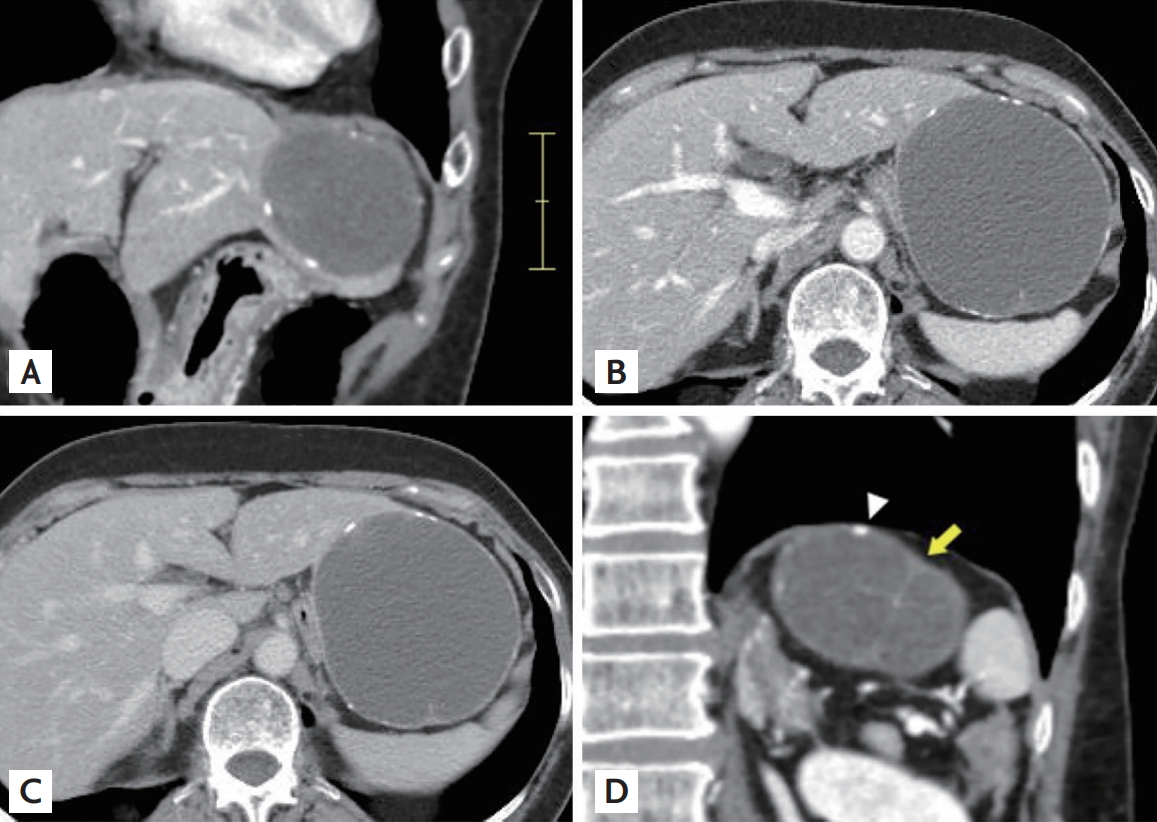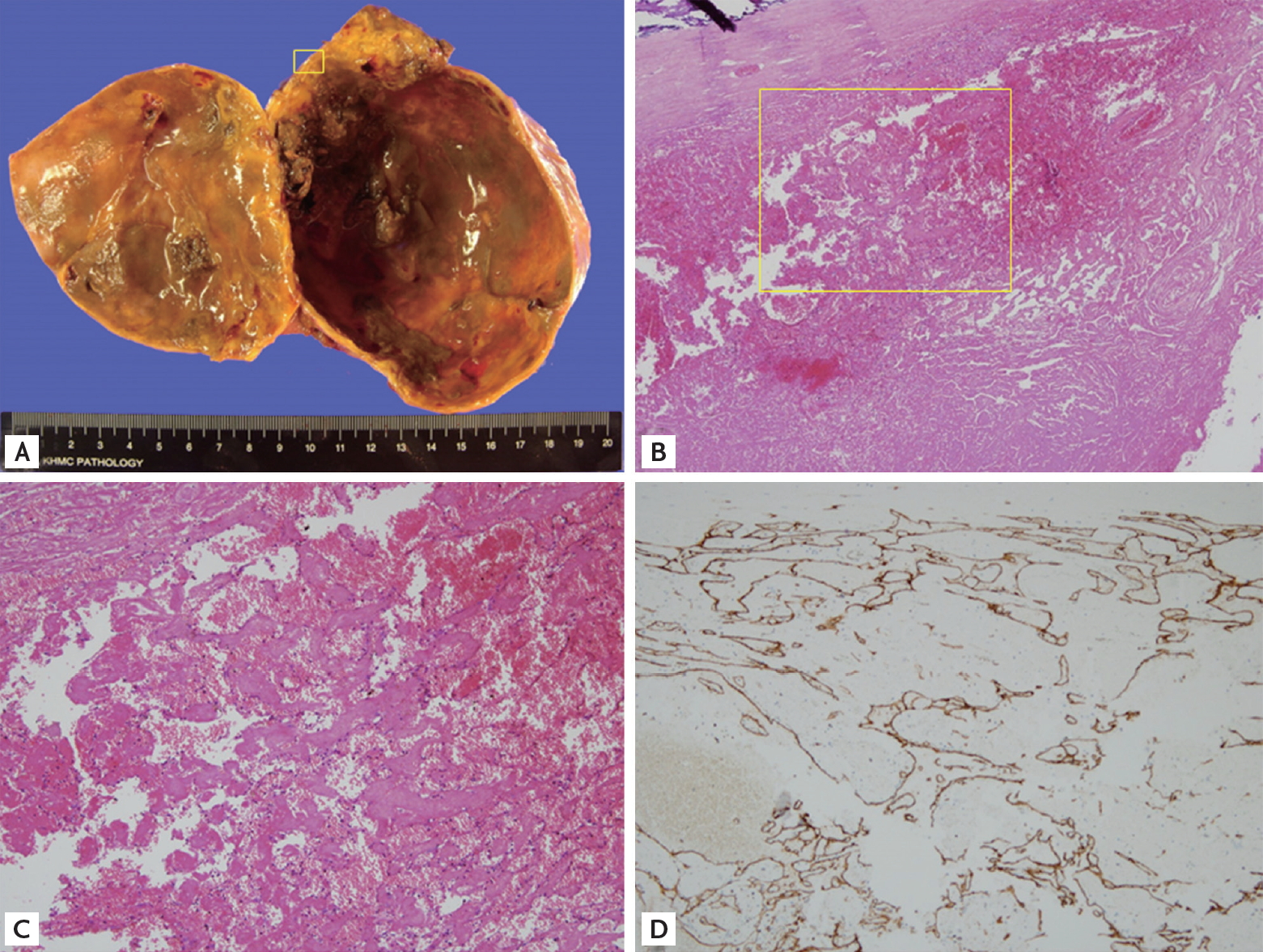 |
 |
| Korean J Intern Med > Volume 36(2); 2021 > Article |
|
A 62-year-old female chronic hepatitis B patient was referred to our clinic after an incidental cystic tumor in her liver was found on abdominal ultrasound. Her serum alanine aminotransferase level was 31 U/L and the hepatitis B virus DNA titer was 1,900 IU/mL. An abdominal ultrasound revealed a hypoechoic cystic tumor measuring 8.2 ├Ś 7.2 cm in the lateral lobe of the liver. A computed tomography (CT) scan showed a large exophytic cyst in the lateral margin in the left lobe (Fig. 1A-1C). A unilocular cyst with multifocal rim calcifications and a thin intracystic septum was observed (Fig. 1D).
A biliary cystadenoma was initially suspected and a laparoscopic approach was employed for tumor resection. The macroscopic cut section showed a brownish round unilocular cyst measuring 9.0 ├Ś 8.0 ├Ś 8.0 cm with a dense fibrous wall having small multifocal calcifications (Fig. 2A). The microscopic view of the cystic wall and small papillary remnants in that showed a dense fibrous wall without lining epithelium. The majority of the solid portion was almost completely necrotized and the remaining lesion had mono-layered endothelial cells and fibrous stroma mixed with blood cells, which indicated hepatic hemangioma (Fig. 2B and 2C). Immunohistochemical staining revealed strong positivity for cluster of differentiation 34 (CD34) and CD31 and negative for cytokeratin 19 (CK19), suggesting an endothelial origin (Fig. 2D). The cystic degeneration following the near-complete necrosis may have altered the presentation of this exophytic hemangioma into that of a cystic tumor.
Hepatic hemangiomas are the most common benign solid tumors in the liver. With ultrasound and CT scans becoming more accessible than ever, the detection of atypical hemangiomas mimicking malignant tumors has increased as well. As this case showed that a hepatic hemangioma can be misdiagnosed as a biliary cystic neoplasm. Thus, hepatic hemangiomas should be included in differential diagnoses of cystic tumors.
Written informed consent was obtained from the patient.
Figure┬Ā1.
Computed tomography images of an exophytic hepatic hemangioma presenting as a large biliary cystadenoma. (A) Coronal image of the cyst from segment 2. (B, C) Transverse image of the tumor showing multiple fine calcifications in the rim. (D) A focal calcification (arrowhead) and thin septum (arrow).

Figure┬Ā2.
Histological view of the cystic tumor. (A) A macroscopic cut section showing a brownish round unilocular cyst with a dense fibrous wall. (B) Microscopic view of the small papillary lesion and cystic wall (the box in Fig. 2A, H&E, ├Ś40). (C) Mono-layered endothelial cells and fibrous stroma mixed with blood (the box in Fig. 2B, H&E, ├Ś100). (D) Immunohistochemical staining strong positivity for CD34, suggesting an endothelial origin (├Ś100)

-
METRICS

- Related articles
-
Hemorrhagic cholecystitis presenting as obstructive jaundice2013 May;28(3)
Parathyroid Carcinoma Presenting as a Hyperparathyroid Crisis2012 June;27(2)
A Case of Gastric Adenocarcinoma Presenting as Meningeal Carcinomatosis2007 December;22(4)
Multiple Myeloma Presenting as a Testicular Mass1994 January;9(1)



 PDF Links
PDF Links PubReader
PubReader ePub Link
ePub Link Full text via DOI
Full text via DOI Download Citation
Download Citation Print
Print


